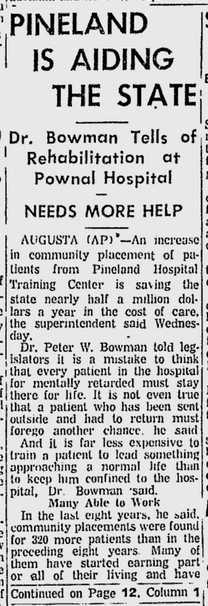As the 20th century hit its midpoint, new ideas were cropping up, including around care for people with developmental disabilities. It was beginning to be understood that services provided in the community were both more humane and less expensive. Superintendent Bowman used the shift in public opinion both to tout Pineland’s successes and ask for more funding, for items like a gymnasium.
“He urged a larger staff to step up the discharge and placement rate: larger federal-aid public assistance grants to help patients who can live outside but can’t earn their way: a diagnostic center to help courts avoid mistaken commitments to the Pownal hospital: and more operating facilities at Pineland, including a gymnasium.” (Lewiston Daily Sun, February 16, 1961)

Even as a new infirmary to “house 134 totally dependent patients” was dedicated, Governor Reed called for more, saying, “the needs of this and other state hospitals continue to grow and ‘our state government must be looking to the future in preparation for taking care of the trends in hospital population which are developing.’” (Lewiston Evening Journal, October 16, 1961)




